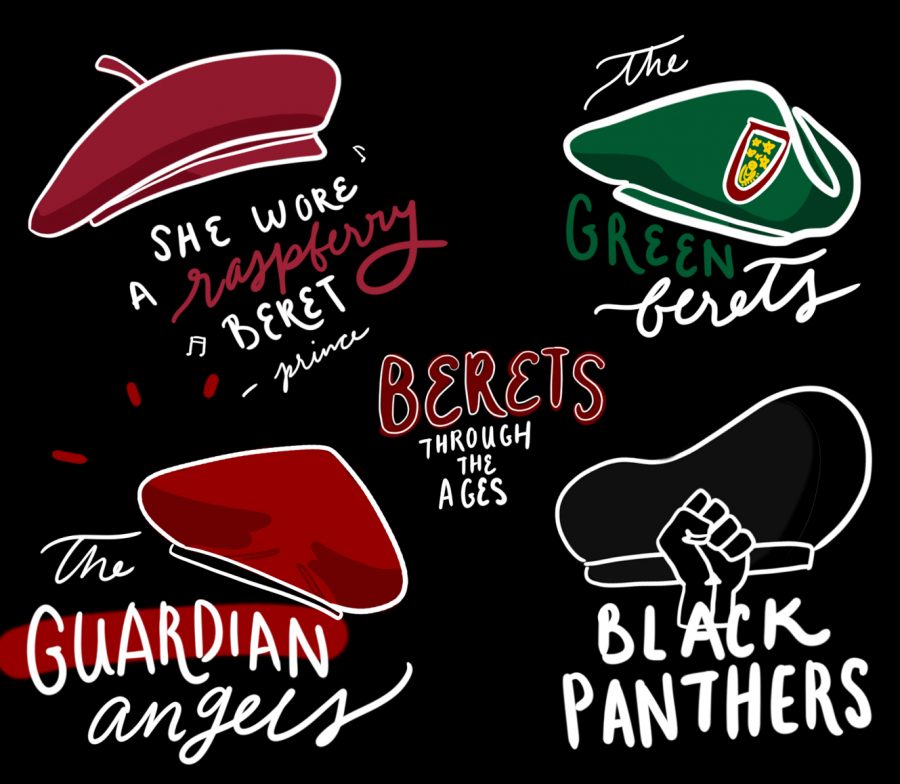The Beret Is Back on Top
March 26, 2018
“She wore a raspberry beret.”
Beyond a Prince lyric, the beret was once considered the national cap of France. Even today, the black beret is very much emblematic of French culture. Many have sported the cute and iconic wearable disc of fabric from Ernest Hemingway to Bridget Bardot to Beyonce at the 2016 Super Bowl Halftime show that emulated the Black Panther Party.
The beret was originally worn by male shepherds on both sides of the Pyrenees mountains that divided Northern Spain and Southern France. However, as archeological evidence has proven, hats similar to berets were worn during the Bronze Age all throughout Europe. Renaissance paintings also show berets as a commonly worn accessory.
However, the early term “bearnais berret” is defined as “flat woolen cap worn by local peasants,” according to Mic. It would soon become a fashion statement. Artists and poets alike sported the hat on the streets of Paris. With the new mass production methods of the 1920s, berets became the headwear of choice for the working class.
Eventually, the traditional beret was adopted by the Belgian Chasseurs Ardennais and the French Chasseurs Alpins. In terms of military incorporation, black berets were worn by Britain’s Royal Tank Regiment in World War I for their ability to hide oil stains. By the 1950s, the United States Army’s Special Forces adopted the green berets, dubbing them “The Green Berets.” In the 1960s, the beret became more political statement than fashion statement. Two of Cuba’s most notable revolutionaries, Che Guevara and Fidel Castro, roused crowds while donning the black felt discs. The black beret was worn by members of the Black Panther Party to reflect their urban military style when marching for the progress of black power in rallies, engendering a sense of empowerment in black communities. In our very own New York City, red berets were worn by the Guardian Angels, an anti-crime citizen patrol formed in the ’70s. In the ’90s, the black beret was attributed to Monica Lewinsky after she was photographed in a black beret the first time she met former-president Bill Clinton. In her interview with Vanity Fair, Lewinsky coyly said it was “time to burn the beret and bury the blue dress.”
Berets are thought to be a dying breed though — the 22 beret factories in Southwestern France have been reduced to one, named Laulhère. Even the 170-year-old beret manufacturer itself thought berets to be dying out. Nevertheless, they are making a comeback. The traditional beret is made of felt woven into a flat crowned hat. Today, berets come in many different designs from various material. Rihanna attended the Dior 2017 Paris Fashion show sporting a leather beret. French actress Lou Lesage, wore a beret of felt with a silk shirt and tailored trousers.
NYU students throughout campus have been caught wearing the French hats. For some, it is a joyful display of their adventures studying abroad in NYU Paris. For others, it’s just for fun or fashion.
“I don’t wear my beret often, but I got it because there was this girl character from the Goofy movie sequel who wore a beret, and that inspired me to get one,” Steinhardt junior Blair Perry said. “I mostly wear mine with a black turtleneck and black pants so I can look like some super intellectual poetic chick. I think that’s a look right now.”
Some have mastered the look, while others simply aspire to rock the look.
“Although I don’t own my own beret just yet, I am very excited to get one to style in the spring, said LS sophomore Ericka Barroso. “Personally I would style a beret with a chic coat and channel a Parisian moment.”
On the other hand, some NYU students feel that berets seem more like a costume accessory than a practical one.
“They look great on the characters in cartoons but I’ve never seen a single person in France actually wear them. Personally, I think they’re not that cute and kind of pointless,” CAS junior Juli Torres said. “I feel like hats should add to the outfit — but I just feel like berets look like droopy attempts at statement pieces instead. I would never wear one.”
A version of this article in the Monday, March 26 print edition. Email Valeria Young at [email protected].
























































































































































